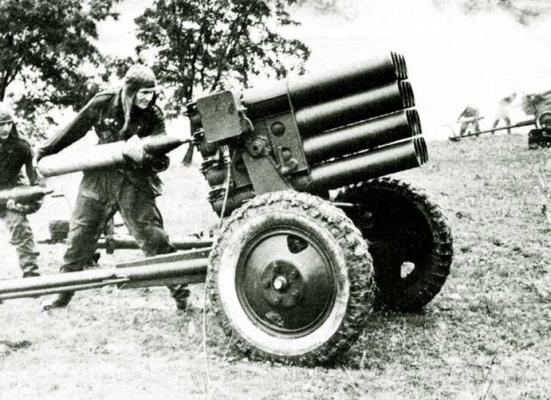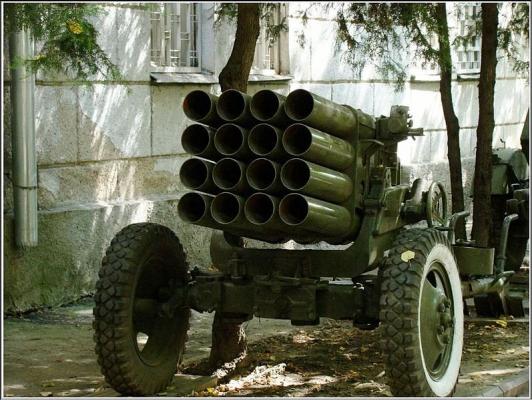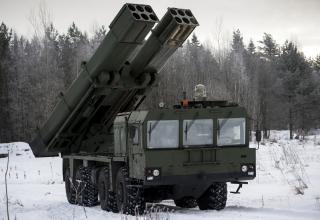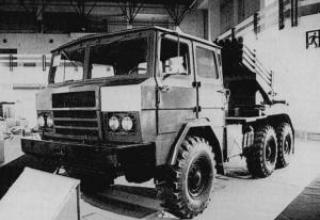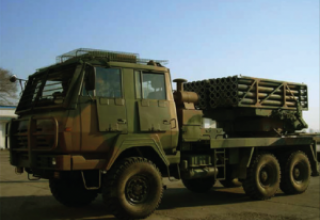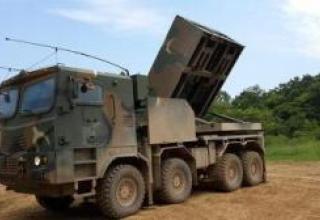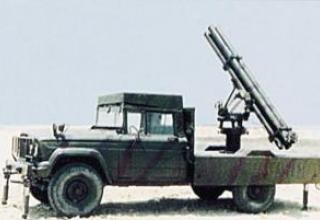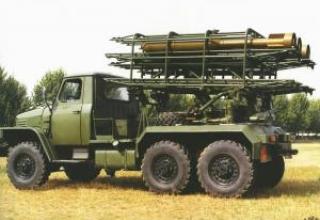In the mid-50s, a towed RPU-14 rocket launcher was developed at GSOCB-43 to launch M-14-OF and M-14D turbojet shells. The launcher was designed primarily for armament of airborne artillery units of the USSR Airborne Forces. It successfully combines small size and weight - with high firepower.
The RPU-14 prototypes were factory tested during 1956. And from May 3 to June 27, 1957, two RPU-14s successfully passed polygon tests, during which they passed 3000 km on the GAZ-63 trailer.
The only foreign analogue is the Polish WP-8 rocket launcher (see photo ©Tomasz Szulc Poland) for firing of 140 mm caliber turbojet shells. This towed launcher, unlike the RPU-14, has an eight barrel guide package (two rows of four barrels each). The Chinese Type-63 turbojet unit can be considered as the Type-63 turbojet unit of 107 mm caliber.
Composition:
The launcher (see side view, rear view) consists of the following main parts: oscillating part, upper machine, lifting gear, swivel gear, lower machine, beds, wheels, sights and electrical equipment.
Wheels from GAZ-AA truck with GC tire and hub from D-44 cannon are used in the chassis design. Torsional podressorivanie, turns on and off automatically when mixing and breeding beds. The package of guides (four rows of four barrels in each) on the welded cradle together with sights is fixed on the upper carriage machine. A sector-type lifting device and a screw-type rotating mechanism are also mounted on the top machine. The machine is fitted with the MP-46M mortar panoramic sight. Lower pressurizing machine is a steel half-cast, inside of which torsional pressurizing and horizon mechanism are assembled. Lower machine is the base of rotating part of the launcher. The tubular frame with permanent coulters is hinged to the bottom machine.
The launcher can be transported by aircraft and dropped by parachute in existing containers; it can be transported behind vehicles (see figure) and tractors, as well as (for short distances) manually by gun calculation. To roll the unit manually, a special roller is placed under the trunk, which is mounted and transported in a walking position on the frames. It takes 2 minutes to move the launcher from the camping position to the combat position. Charging of the launcher is carried out manually. Calculation - 5 persons.
The RPU-14 launcher could be effectively used:
-
when firing M-14-OF shells:
- to suppress (destroy) the enemy's manpower and firepower located openly or behind easy hiding places;
- for suppression (destruction) of enemy artillery and mortar batteries and rocket launchers;
- to destroy light field tree and earth structures.
- When firing M-14D shells:
- To smoke enemy observation points and firing points;
- for target designation or shooting;
- to create smoke screens.
During firing, the control panel and the calculation must be located in a shelter or at a distance safe from the gas jet of projectiles (50-60 m from the launcher). The remote reel is intended for firing from a shelter located at a distance of up to 80 m from the launcher.
The RPU-14 could be effectively used for firing support of the troops during the landing operations and when fighting in hard-to-reach terrain.
Characteristics:
| Range of fire, m: - maximum - minimum |
9810 2000 |
| Structural data: | |
| Barrel caliber, mm | 140.3 |
| Shaft number | 16 |
| Barrel length, mm | 1150 |
| Largest elevation angle | 50° |
| Maximum angle of reduction | 2.5° |
| Horizontal guidance corners | ±12° |
| Dimensional data | |
| Dimensions mm: - length of the launcher when the beds are folded together - hiking altitude - mounting width - stroke width - hiking clearance |
4150 1450 1730 1440 320 |
| Weight data | |
| Weight, kg: - charged launcher - launcher without shells - bobbin - control desk |
1560 925 12 18 |
| Operational data | |
| The minimum time required to produce a full salvo, s | 8-10 |
| Time of transition from marching position to combat position (without recharging), min | 2 |
| Time of transition from combat to camping, min | 2 |
| Time required to charge the launcher, min. | 3 |
| The force on the handle of the lift mechanism, kg: - when the clutch is pushed down - tightly clamped |
not more than 8 not less than 12 |
| Turning handle force, kg | not more than 3 |
| Vertical aiming speed in one turn of the flywheel | 37,6' |
| Horizontal aiming speed in one turn of the flywheel | 31' |
| Speed of carriage behind the tractor with and without shells in the barrels, km / h: - on the right track - on the cobblestone paving - off-road |
up to 65 up to 30 up to 15 |
Testing:
In 1974, the RPU-14 rocket launcher was still in service with the Soviet Army and was used in mountainous conditions.
Sources:
- Гуров С.В. "Реактивная артиллерия иностранных государств, ФГУП ГНПП "Сплав", 2008г. Депанировано в ВИНИТИ.
- Носовицкий Г.Е. Продолжение "Катюши". – М.: "Вузовская книга", 2005 – С.568-569.
- Реактивная пусковая установка РПУ-14. Руководство службы. М.: Воениздат. – 1961. – С. 3-6,127.
- Шунков В.Н. 'Ракетное оружие',изд."ПОПУРРИ",Минск,2001 г.
- Красная звезда. - 08 февраля 1974 года. - №33 (15301). - С. 1.
- Красная звезда. - 06 декабря 1974 года. - №285 (15553). - С. 1.
